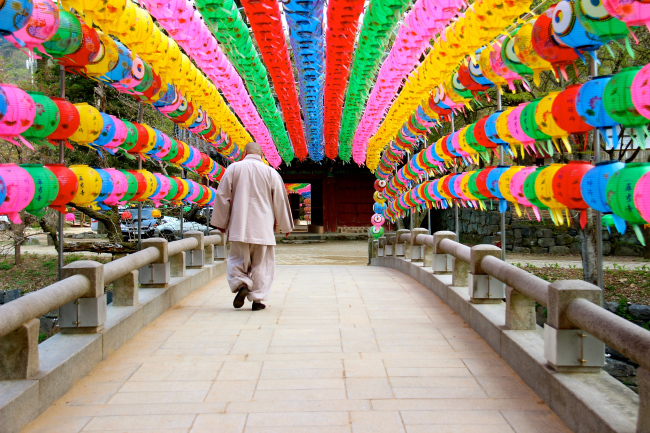In traditional Korean culture, people bow once when greeting the living, twice when paying respect to the dead and three times when venerating a Buddhist shrine or a senior monk or nun.
“So why do we bow three times to a monk?” an instructor asked in a bowing tutorial session during a three-day templestay program at Magoksa Temple in Gongju, South Chungcheong Province.
“Because they are more than human,” one Chinese exchange student hesitantly replied, unsure whether her answer was correct.
“Good answer,” the instructor responded with a smile.
In fact, bowing three times is not merely a symbolic act. Rather, each bow has a specific purpose and intended recipient. The first bow is meant to show one’s devotion to Buddha, followed by another bow for the dharma (the teachings) and then a third bow for the sangha (the Buddhist community). According to Buddhist beliefs, ordained monks and nuns are vessels of the Buddha’s teaching; therefore, followers are to offer three bows to a senior monk, as they would to a shrine for the holy one.
The practice of Buddhism has and continues to have deep historical roots in Korean society. Temples can be found scattered throughout the small peninsula and in order to preserve the almost 1,700-year history and tradition of Korean Buddhism, many temples offer unique templestay programs that allow believers and nonbelievers, locals and foreigners alike the opportunity to experience Buddhist life.
 |
Magoksa Temple grounds in Gongju, South Chungcheong Province (Julie Jackson/The Korea Herald) |
Magoksa Temple is nestled between the plush green valleys of Mount Taehwasan and the pristine Taegeukcheon River, approximately a two-and-a-half-hour drive from Seoul. The temple, considered the most historically valuable Buddhist temple in all of South Chungcheong Province, offers a variety of customized templestay programs almost every day of the year.
Whether on a hunt for inner peace, solitude from city life or a chance to ponder some of life’s most philosophical and impossible-to-answer questions, a couple of nights at a remote, picturesque temple may just be the best solution.
Buddhist philosophy and practice is centered upon the struggle to achieve inner enlightenment and spiritual cleansing. “All that we are is the result of what we have thought. The mind is everything. What we think we become,” Buddha once said. “All wrongdoing arises because of mind. If the mind is transformed, can wrongdoing remain?”
These are the sort of existential thoughts and questions one may be asked to contemplate and discuss during a templestay experience.
Aside from “spiritual,” if there is one other word that illustrates a day in the life of an ordained Buddhist monk, it would undoubtedly be “disciplined.” In accordance with the Vinaya ― the Buddhist framework laying out the obligations of the Buddhist community ― the lifetime commitment of being a servant of the Buddha means ridding one’s life of almost all material luxuries as well as adhering to a strict vegetarian diet and taking a vow of celibacy, among other sacrifices.
Templestay participants do not simply dress in loose-fitting monk robes and meditate all day, but take part in various educational sessions to learn the true essence of temple life, which includes waking up at 3 a.m. and lights out at 9 p.m. From learning to thoroughly appreciate the wonders of nature ― right down to a single blade of grass ― through early morning walks in the open hillsides, to understanding the deepest sanctity of silence, the Magoksa Templestay programs emphasize the teachings of the Buddhist ways.
By sitting, sleeping and meditating on the floor, participants are asked to rid their minds of nonessentials. Cellphones and all other electronic devices must be left in the quarters. And for those who are unsure whether they can go without TV and communication with the “real world,” the hushed serenity and metaphysical aura of the temple surroundings should more than fill these technological voids. If that doesn’t do the trick, the mandatory ullyeok, daily communal chores, will surely keep one’s hands busy.
During a templestay, visitors can also have the opportunity to participate in a barugongyang, a formal monistic meal ceremony with a monk. Here, one will learn the intricacies and step-by-step process ― almost too many steps to remember on the first attempt ― of eating a traditional ceremonial meal.
While sitting on the floor in the lotus position (cross-legged), one must place four different-sized stacked bowls in a specific order, with chopsticks being placed at a certain angle inside a bowl, and then strategically filling each bowl with food. The ceremony, from the first step of organizing one’s bowls and throughout the entire eating process, must be done without making a sound. On top of upholding the tradition of eating in silence, one will be instructed not to leave a single morsel of food in the bowls, which is actually a strict rule for all the temple meals.
Templestays are indeed a one-of-a-kind experience that should be tried at least once during one’s lifetime. However, despite its many programs, I must say one of the biggest downfalls of the Magoksa Templestay experience was learning that participants do not actually get to sleep on the temple grounds. Had I known that nights were going to be spent in modern facilities located just a short walk from the temple and not on the temple grounds ― which many other templestays allow ― I would have altered my expectations.
For more information on Magoksa Temple and other Templestay locations, visit eng.templestay.com.
How to get there
Magoksa Temple can be reached via bus and taxi. From the Seoul Express Bus Terminal, take the express bus to Gongju (tickets cost about 9,000 won), about a two-hour ride.
From the terminal, taxis are the only form of public transportation that reach the temple; the drive will take around 20-30 minutes and cost around 25,000 won (note that many cabs in the area do not accept credit cards).
By Julie Jackson (
juliejackson@heraldcorp.com)








